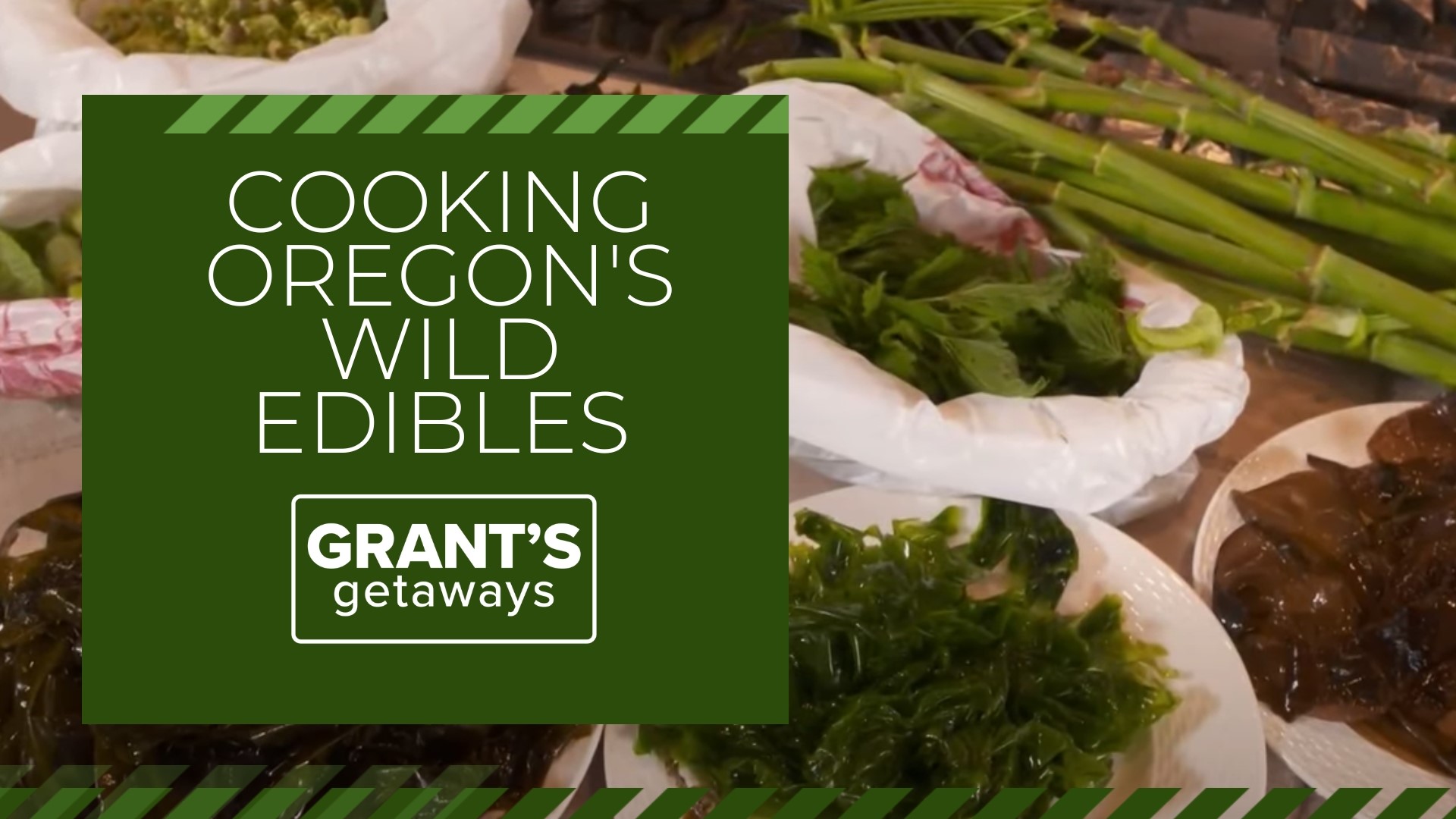FOREST GROVE, Ore — I’m an Oregonian who prefers the roads less traveled! That is most likely the result of a childhood largely spent exploring Oregon’s rugged Cascade Mountains and vast high desert landscape. Couple that with abundant fishing and hunting adventures and the net result is a strong appreciation for the idea of “living off the land.”
So, this week’s outdoor adventure is right up my alley as we head to the kitchen with a wild edible expert and cook up a delicious wild foods feast.
John Kallas recently showed me that when the tide goes out the dinner table is set: from salty, crunchy seaweeds to digging abundant “Butter Clams” that taste just like the name suggests. Plus, a hike through an Oregon rain forest to collect fresh salad fixings like cascade sorrel, salmonberry blossoms, lady fern fiddle heads and more.
“All the wild foods that we collect today,” noted Kallas, “is like finding treasure. These plants are valuable because we can prepare them for a dinner that’s delicious and fun.”
Kallas is a big believer that wild foods are just traditional foods that we have lost touch with through the passage of time and the conveniences that 21st century consumers expect – including mega mart grocery stores.
In my Forest Grove kitchen, Kallas directed an “all hands-on deck” group of friends who went to work preparing a unique and delicious wild edible feast.
Everyone lent a hand in the sorting, cleaning and chopping to create a seaweed salad that included crunchy “angel-wing kelp,” spicy “teriyaki seaweed” and “sea lettuce;” the greenest of all the seaweeds.
We also created a wild green salad that included cascade sorrel, salmonberry blossoms and maple tree flower clusters – each is edible and delicious!
John’s good friends and recent wild food devotees, Charla Ochse and Halina Lewandowski, showed off their homemade dishes including a “butter clam stir fry.” It was delicious and included fiddle head ferns, chopped red and yellow peppers and “stinging nettles.”
“Ouch,” I said at the thought of those nettles.
John quickly noted, “Once they are cooked, they soften and are totally harmless and very delicious.”
The main entree of our feast was a huge pot of clam chowder that included potatoes, onions, more fiddle head ferns and heaping bowls of chopped butter clams.
John’s technique for prepping the clams was simple enough: par-boil the clams until they open and then he deftly slipped a sharp knife blade between the shells and cut the clam’s abductor muscles to pry open the clam.
A reminder: each clam digger must have an Oregon Shellfish License and must dig their own daily limit of 20 butter clams.
I wondered aloud what made the butter such a fine centerpiece for a chowder and John replied that it’s all about the size of the clam:
“When you open the shell of a butter clam, you can see that the shell is filled with meat. There’s absolutely no wasted space inside the clam shell and it’s all good to eat.”
Kallas called many of the wild foods that we had gathered, “forgotten foods;” especially the plants that have been largely lost to time and lost cultures.
“Native Americans gathered all year long,” said Kallas. “They would process, process, process and then store most of it. They would be doing this all year long and eat off the diversity of the food sources. That’s how native peoples got a complete diet.”
Judging from the results of our wild edible feast, each dish was a big hit with the crowd.
“Oh, it is all so very good,” said Ochse. “I really loved the seaweed salad with ginger dressing – that was delicious.”
Dining guest Bob Waldron added, “There isn’t anything here that I don’t like and wouldn’t eat multiple times if given the opportunity. It was all so good and it was really fun going out and getting it.”
Kallas said that while he enjoyed making the gathering and cooking wild edibles experiences fun and satisfying, he admitted that his ultimate goal is to get people closer to the planet, so they’ll take better care of it.
“If you know that you are gathering your food from Mother Nature and you see people spraying chemicals it should probably be of concern to you. So, the more people realize that food doesn’t just come from the supermarket they’ll be more protective of their land and better off altogether.”
Kallas cautioned that knowing exactly what you harvest is critical safety when it comes to collecting and eating Oregon’s wild edibles. He suggested taking a wild edibles foraging class or reading the right book – like his “Edible Wild Plants – From the Dirt to the Plate.”
The text identifies most of the wild edibles you will find in Oregon and also includes gorgeous colorful photos to show you what each plant looks like. There are also plentiful recipes that explain what to do with your abundance.
Be sure to watch the weekly half hour program of Grant’s Getaways. The show airs each Saturday and Sunday at 4pm on KGW.
For something different, you can follow my Oregon adventures via the Grant’s Getaways Podcast: Each segment is a story-telling session where I relate behind the scenes stories from four decades of travel and television reporting.
You can also learn more about many of my favorite Oregon travels and adventures in the Grant’s Getaways book series, including:
- "Grants Getaways I," Photography by Steve Terrill
- "Grant's Getaways II," Photography by Steve Terrill
- “Grant’s Getaways: 101 Oregon Adventures,” Photography by Jeff Kastner
- “Grant’s Getaways: Guide to Wildlife Watching in Oregon,” Photography by Jeff Kastner
- “Grant’s Getaways: Oregon Adventures with the Kids,” Photography by Jeff Kastner
The book collection offers hundreds of outdoor activities across Oregon and promises to engage a kid of any age.
You can reach me: Gmcomie@kgw.com

